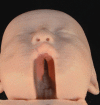3D Printed Models of Cleft Palate Pathology for Surgical Education
- PMID: 27757345
- PMCID: PMC5055011
- DOI: 10.1097/GOX.0000000000001029
3D Printed Models of Cleft Palate Pathology for Surgical Education
Abstract
To explore the potential viability and limitations of 3D printed models of children with cleft palate deformity.
Background: The advantages of 3D printed replicas of normal anatomical specimens have previously been described. The creation of 3D prints displaying patient-specific anatomical pathology for surgical planning and interventions is an emerging field. Here we explored the possibility of taking rare pediatric radiographic data sets to create 3D prints for surgical education.
Methods: Magnetic resonance imaging data of 2 children (8 and 14 months) were segmented, colored, and anonymized, and stereolothographic files were prepared for 3D printing on either multicolor plastic or powder 3D printers and multimaterial 3D printers.
Results: Two models were deemed of sufficient quality and anatomical accuracy to print unamended. One data set was further manipulated digitally to artificially extend the length of the cleft. Thus, 3 models were printed: 1 incomplete soft-palate deformity, 1 incomplete anterior palate deformity, and 1 complete cleft palate. All had cleft lip deformity. The single-material 3D prints are of sufficient quality to accurately identify the nature and extent of the deformities. Multimaterial prints were subsequently created, which could be valuable in surgical training.
Conclusion: Improvements in the quality and resolution of radiographic imaging combined with the advent of multicolor multiproperty printer technology will make it feasible in the near future to print 3D replicas in materials that mimic the mechanical properties and color of live human tissue making them potentially suitable for surgical training.
Conflict of interest statement
The authors have no financial interest to declare in relation to the content of this article. This study was supported by Monash University Centre for Human Anatomy Education—3D printing equipment and software. The Article Processing Charge was paid for by the authors.
Figures




Similar articles
-
Applying 3D surface scanning technology to create photorealistic three-dimensional printed replicas of human anatomy.Future Sci OA. 2024 Dec 31;10(1):2381956. doi: 10.1080/20565623.2024.2381956. Epub 2024 Aug 13. Future Sci OA. 2024. PMID: 39135497 Free PMC article.
-
Preoperative Planning and Simulation in Patients With Cleft Palate Using Intraoral Three-Dimensional Scanning and Printing.J Craniofac Surg. 2019 Oct;30(7):2245-2248. doi: 10.1097/SCS.0000000000005983. J Craniofac Surg. 2019. PMID: 31513038
-
Evaluation of a 3D-Printed Cleft Palate Obturator Using a Low-Dose Cone Beam Computed Tomography Acquisition Protocol: A Proof-of-Concept Study.Cureus. 2024 Apr 4;16(4):e57602. doi: 10.7759/cureus.57602. eCollection 2024 Apr. Cureus. 2024. PMID: 38577166 Free PMC article.
-
Increasing the functionalities of 3D printed microchemical devices by single material, multimaterial, and print-pause-print 3D printing.Lab Chip. 2018 Dec 18;19(1):35-49. doi: 10.1039/c8lc00826d. Lab Chip. 2018. PMID: 30475367 Review.
-
Accuracy of 3D Printed Models Created by Two Technologies of Printers with Different Designs of Model Base.J Prosthodont. 2020 Feb;29(2):124-128. doi: 10.1111/jopr.13107. Epub 2019 Sep 9. J Prosthodont. 2020. PMID: 31498957 Review.
Cited by
-
Radiological Society of North America (RSNA) 3D printing Special Interest Group (SIG): guidelines for medical 3D printing and appropriateness for clinical scenarios.3D Print Med. 2018 Nov 21;4(1):11. doi: 10.1186/s41205-018-0030-y. 3D Print Med. 2018. PMID: 30649688 Free PMC article.
-
Role of innovative 3D printing models in the management of hepatobiliary malignancies.World J Hepatol. 2019 Jul 27;11(7):574-585. doi: 10.4254/wjh.v11.i7.574. World J Hepatol. 2019. PMID: 31388399 Free PMC article. Review.
-
A state-of-the-art guide about the effects of sterilization processes on 3D-printed materials for surgical planning and medical applications: A comparative study.Int J Bioprint. 2023 May 17;9(5):756. doi: 10.18063/ijb.756. eCollection 2023. Int J Bioprint. 2023. PMID: 37555083 Free PMC article.
-
Three-Dimensional Printed Polylactic Acid (PLA) Surgical Retractors with Sonochemically Immobilized Silver Nanoparticles: The Next Generation of Low-Cost Antimicrobial Surgery Equipment.Nanomaterials (Basel). 2020 May 21;10(5):985. doi: 10.3390/nano10050985. Nanomaterials (Basel). 2020. PMID: 32455641 Free PMC article.
-
A novel paradigm in cleft lip education: integration of 3D-printed simulator and problem-based learning.BMC Med Educ. 2025 Jul 26;25(1):1116. doi: 10.1186/s12909-025-07719-1. BMC Med Educ. 2025. PMID: 40713631 Free PMC article. Clinical Trial.
References
-
- Mastroiacovo P, Maraschini A, Leoncini E, et al. Prevalence at birth of cleft lip with or without cleft palate: data from the International Perinatal Database of Typical Oral Clefts (IPDTOC). Cleft Palate Craniofac J. 2011;1(48):66–81. - PubMed
-
- Tanaka SA, Mahabir RC, Jupiter DC, et al. Updating the epidemiology of isolated cleft palate. Plast Reconstr Surg. 2013;131:650e–652e. - PubMed
-
- Katzel EB, Basile P, Koltz PF, et al. Current surgical practices in cleft care: cleft palate repair techniques and postoperative care. Plast Reconstr Surg. 2009;124:899–906. - PubMed
-
- Martin L, Delbridge L, Martin J, et al. Trainee surgery in teaching hospitals: is there a cost? Aust N Z J Surg. 1989;59:257–260. - PubMed
LinkOut - more resources
Full Text Sources
Other Literature Sources
